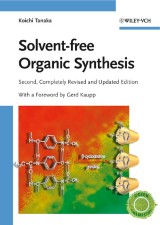Details

Solvent-free Organic Synthesis
2nd Completely Revised and Updated Edition
|
196,99 € |
|
| Verlag: | Wiley-VCH |
| Format: | |
| Veröffentl.: | 17.12.2008 |
| ISBN/EAN: | 9783527626427 |
| Sprache: | englisch |
| Anzahl Seiten: | 468 |
DRM-geschütztes eBook, Sie benötigen z.B. Adobe Digital Editions und eine Adobe ID zum Lesen.
Beschreibungen
<p>In this <i>second edition</i> of a best-selling handbook all the chapters have been completely revised and updated, while four completely new chapters have been added. In order to meet the needs of the practitioner, emphasis is placed on describing precisely the technology and know-how involved. Adopting a didactic and comprehensible approach, the book guides the reader through theory and applications, thus ensuring its warm welcome among the scientific community.</p> <p>An excellent, essential and exhaustive overview.</p>
<p>REDUCTION</p> <p>Solvent-Free Reduction</p> <p>OXIDATION</p> <p>Solvent-Free Oxidation</p> <p>CARBON-CARBON BOND FORMATION</p> <p>Solvent-Free C-C Bond Formation</p> <p>Solvent-Free C-C Bond Formation under Photoirradiation</p> <p>CARBON-NITROGEN BOND FORMATION</p> <p>Solvent-Free C-N Bond Formation</p> <p>CARBON-OXYGEN BOND FORMATION</p> <p>Solvent-Free C-O Bond Formation</p> <p>Solvent-Free C-O Bond Formation under Photoirradiation</p> <p>CARBON-SULFUR BOND FORMATION</p> <p>Solvent-Free C-S Fond Formation</p> <p>CARBON-PHOSPHOORUS BOND FORMATION</p> <p>Solvent-Free C-P Bond Formation</p> <p>CARBON-HALOGEN BOND FORMATION</p> <p>Solvent-Free C-X Bond Formation</p> <p>NITROGEN-NITROGEN AND NITROGEN-SULFUR BOND FORMATION</p> <p>Solvent-Free N-N Bond Formation</p> <p>Solvent-Free N-S Bond Formation</p> <p>REARRANGEMENT</p> <p>Solvent-Free Rearrangement</p> <p>Solvent-Free Rearrangement under Photoirradiation</p> <p>ELIMINATION</p> <p>Solvent-Free Elimination</p> <p>PROTECTION</p> <p>Solvent-Free Protection</p> <p>DEPROTECTION</p> <p>Solvent-Free Deprotection</p> <p>POLYMERIZATION</p> <p>Solvent-Free Polymerization</p> <p>Solvent-Free Polymerization under Photoirradiation</p> <p>SUPRAMOLECULAR COMPLEXATION</p> <p>Solvent-Free Supramolecular Complexation</p> <p>LIST OF JOURNALS</p>
"Solvent-free Organic Synthesis is a long-needed and timely compilation of experimental procedures that do not use solvents during the reaction step. Even better, it also includes numerous syntheses that do not require solvents after the reaction for extraction, chromatography, or recrystallization, because they yield pure products in the absence of auxiliaries...This is a must-have book for all students (perhaps through libraries) and academic or industrial researchers who honestly want to use and improve sustainable syntheses, and can also be recommended for administrators and referees who control the funding of such endeavors for the well-being of our environment."<br> Gerd Kaupp<br> Organic Chemistry I<br> University of Oldenburg (Germany)<br> in: Angewandte Chemie/International Edition 40/03<br> <br> "... a long-needed and timely compilation...this is a must-have book for all students and academic or industrial researchers."<br> Angewandte Chemie Intl.<br> <br> "...offers graphical summaries of 537 examples of solvent-free organic reactions..."<br> Journal of the American Chemical Society<br> Vol. 125, No. 39<br> <br> "In conclusion, this book constitutes an essential handbook in an excellent and exhaustive overview compilation. It is highly recommended to all those concerned with Green Chemistry as a valuable resource in the field."<br> A. Loupy, Paris-South University and CNRS, France<br> Synthesis 2003, No. 16
Koichi Tanaka became full professor at the faculty of Chemistry, Materials, and Bioengineering at Kansai University in 2004. His many publications cover the topics of substance transformation in organic chemistry. He is author of the best selling book by Wiley-VCH "Solvent-free Organic Synthesis".
Synthetic chemistry has long been dominated by reactions in solvents that are all too often toxic or otherwise damaging to the environment. Thus, when it comes to minimizing the amount of toxic waste, solvents are an especially important factor, since they are usually used in large quantities. The introduction of cleaner technologies to replace harmful solvents has become a major concern. Yet the greenest solvent is no solvent at all. <br> In this second edition of a best-selling handbook all the chapters have been completely revised and updated, while four completely new chapters have been added. In order to meet the needs of the practitioner, emphasis is placed on describing precisely the technology and know-how involved. Adopting a didactic and comprehensible approach, the book guides the reader through theory and applications, thus ensuring its warm welcome among the scientific community. <br> An excellent, essential and exhaustive overview for chemists, as well as organic, polymer and physical chemists, and those working in industry.

















